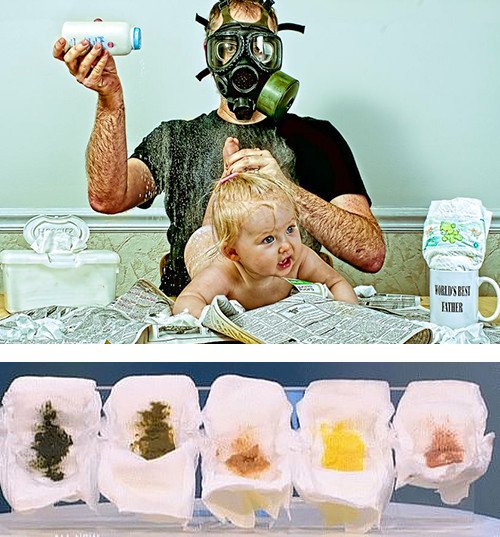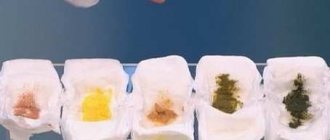Yellow stool in a newborn
If a child has loose, bright yellow stools, parents should not worry prematurely. This type of bowel movement can be either normal or pathological, depending on the presence or absence of accompanying symptoms. Why exactly yellow? The fact is that bilirubin is responsible for coloring this color. Yellow-brown in color and formed during the breakdown of hemoglobin. Bilirubin is excreted in the poop as bile. Its quantity determines the color of stool.
In case of pathologies, the stool will contain the following inclusions:
- The presence of small white inclusions will indicate to parents that the baby is overeating. At the same time, the baby gains weight normally and does not complain of discomfort. But, if the baby is not gaining well, and white lumps or grains are found in the stool, this indicates insufficient production of enzymes. This means that food will be poorly broken down and digested.
- Yellow stool with mucus in infants indicates the presence of inflammatory processes in the intestines. For example, such a picture is observed with atopic dermatitis, early complementary feeding or improper introduction of foods.
- If there is foam in the stool, one can judge increased gas formation or dysbacteriosis, an intestinal infection. However, in addition to this, the child may also suffer from other symptoms - vomiting, nausea, hypersalivation, abdominal pain, colic.
- There is normally no bleeding. Blood in the stool may appear as a result of damage to the intestinal walls by a foreign body, as a reaction to an incorrectly introduced product into complementary foods. A striking example of such a violation can be cherries, dairy products, and grapes.
Early feeding is taboo!
There is a difference in the amount of feces a baby has, depending on the type of feeding. According to the Ministry of Health, according to the latest regulations, a child under six months is not recommended to eat anything other than breast milk or an adapted milk formula. A few decades ago, children were introduced to their first complementary foods after the third month, but it has been scientifically proven that this has a negative impact on future health. A child who has experienced such experiences early on may become allergic, have problems with the gastrointestinal tract, and dysbacteriosis.
The influence of nutrition on the nature of bowel movements
In addition, the nature of feeding affects the child’s stool: breastfeeding, mixed or artificial feeding. In addition, after the introduction of complementary foods, the child’s stool changes and becomes more shaped and may smell differently.
Breast-feeding
Dr. Komarovsky and lactation consultants believe that stool during breastfeeding should be uniform, have a sour milk smell, yellow, and without inclusions. In addition, its absence for several days is not considered constipation. This is a normal phenomenon during guards. However, nothing should bother the baby. The number of bowel movements depends on the age of the child.
The reason for changes in stool characteristics is due to changed foods. On breastfeeding, baby feces, its consistency, color and smell depend on the microbial flora. When breastfeeding, bifidumflora predominates. The baby's stool is watery, mushy, without inclusions and has a sour-milk odor. Color: bright yellow. The frequency of stools in the first half of the year is 2–4 times a day, in the second half of the year 1–2 times.
Artificial feeding
When artificial mixtures are introduced, bifidumflora is replaced by acedophilus bacilli and enterococci. In this case, the baby's stool will have a denser consistency and have an unpleasant sour smell. For the most part, stool with properly selected formula is yellow. But here the frequency of bowel movements often does not exceed 2 times a day. The consistency is dense and shaped. There are no inclusions. White specks in stool indicate overeating.
Mixed feeding
With mixed nutrition, the baby is subjected to real tests. This is due to the different consistency of breast milk and formula. The latter is very dense and nutritious, due to which it takes longer to digest, and breast milk is completely absorbed and consists of 90% water. The baby’s body has a hard time getting used to this type of feeding, which is why constipation or diarrhea and colic are possible. The color of the stool varies from yellow-sandy to yellow-brown without inclusions. The consistency is creamy, the smell is sour.
Lure
When adding crumbs of new foods to the diet, you should carefully monitor his stool. If the product is not suitable, the baby’s feces and general well-being will tell you about it. Ideally, stool should be free of impurities and undigested food. But often parents give their child food to try a little earlier than allowed or do not puree it. For example, pieces of boiled potatoes or carrots, small pasta can “come out” as a whole. This is due to the same insufficient production of enzymes. If the baby feels great, then you just need to adjust the diet and consistency of the food.
When introducing complementary foods, the color of the stool depends on the food chosen, most often yellow-brown or brown. Frequency 2 – 3 times a day. The smell is sour, the consistency is dense, there may be undigested particles.
What is meconium? What does he look like?
After birth, the baby changes and grows extremely quickly, and the mother needs to carefully monitor all the changes. A newborn baby must cleanse its intestines immediately after birth. While in his mother's tummy, he also ate, and processed products accumulated for many months. The first stool (meconium) is fairly hard stool, it is dark green in color and dense. Its discharge should end on the second day at most. Then the stool becomes like mush, only sometimes with a small admixture of meconium and only in the first few days. This is the so-called transitional chair, and it already shows how correctly and competently the mother and doctors create a diet for the child.

Normal indicators
According to organoleptic indicators, the feces of a newborn child and a one-year-old child cannot be the same.
| Child's age | Character (color, volume, smell, consistency, impurities) |
The presence of such an indicator as bilirubin in feces is allowed only in recently born children who are on guard duty. In all other cases it is unacceptable. Sometimes greenish-colored feces in such infants are considered normal until the age of six months.
When to sound the alarm
The parent’s worries are justified if the baby has other clinical signs along with indigestion:
- increased body temperature;
- rash;
- vomiting accompanied by hypersalivation;
- abdominal pain of various origins.
The baby’s bowel movements will be no less informative.
A stool that has no color will shock any parent. And not without reason, since this pathology will indicate a disturbance in the liver (jaundice, hepatitis); Foamy stool indicates lactase deficiency and increased gas formation. This problem often occurs in babies born prematurely.
Green stool does not always indicate pathology, since in the first hours and days of life newborns have greenish stool. And then it will appear again with the introduction of mixtures or complementary foods. With prolonged physiological jaundice, the baby's stool may be green in color. This is due to the fact that there is quite a lot of bilirubin in his body, which is excreted in feces. And since there is a lot of it, the color of the stool becomes green.
It is necessary to pay attention to both constipation and diarrhea. Since most often with diarrhea, the stool is foamy, with mucus or streaked with blood. If the amount of feces has become significantly less, and the presence of solid and formed masses is noticed, and then liquid ones, or there are inclusions, then this state of affairs indicates a violation of the composition and norms of the baby’s nutrition or improper complementary feeding.
Baby feces while breastfeeding
When breastfeeding, normal stools should be mushy, light yellow in color, and smell like sour milk. Various impurities, excessive wateriness, foam, greenishness, mucus may indicate intestinal dysfunction or poor nutrition of the mother. Each situation requires consultation with a specialist, because it may be a symptom of an intestinal infection, lactose intolerance, insufficient amounts of enzymes or dysbiosis. Before subjecting a child to all the circles of hell in clinics, it is better to carefully study his condition; if he develops well, grows, does not cry and generally looks healthy and happy, then perhaps such a baby’s feces is his norm, and it does not require medical intervention.
Newborn stool. Constipation in infants. The color and consistency of the child's stool.
With the birth of a child, a mother has a lot of fears related to the baby’s health and proper care for him. These fears are not difficult to allay.

Young parents look at the contents of a baby diaper with interest and trepidation. Is this a familiar picture? The stool often causes anxiety in the mother and can really tell about the health and unhealthiness of the baby - you just need to be able to “read between the lines,” that is, understand the signs of the body.
Let's get to know the norm
While the baby lives and develops in the mother's womb, meconium accumulates in his intestines. It is a homogeneous tar-like mass of dark olive, almost black color, practically odorless. It consists of condensed cells of the intestinal mucosa, amniotic fluid swallowed by the baby, etc. Normally, meconium begins to be released from the baby’s intestines after birth and therefore is also called original feces (sometimes meconium is released in utero: in case of unfavorable course of labor or at the very end of pregnancy, oxygen starvation the fetus causes premature bowel movement, in which case meconium enters the amniotic fluid and turns it green). The baby's stool is usually represented by meconium in the first two or three days, that is, until the mother produces a large amount of milk. Sometimes it happens that after the bulk of the meconium has passed, say, during the first day, until the mother’s milk arrives, the baby may not have any stool at all. This is due to the fact that the colostrum, which the baby eats in the first few days, is absorbed by the body almost completely, so that there are no toxins left in the intestines - therefore, there is simply nothing to be excreted.
After the mother has established active lactation, the baby’s stool gradually becomes mature, usually passing through a transitional stage. Transitional stool is a stool that combines the features of original stool and mature stool; it has a mushy consistency, a yellow-green color and a sour odor. Mature stool is distinguished by a pure yellow color, a homogeneous mushy consistency (it is often compared to thin sour cream), and the smell of sour milk. Its frequency is higher, the younger the child: in the first weeks after birth, bowel movements can occur almost after every feeding, that is, up to and sometimes 10 times per day.
Gradually, stool is reduced to approximately once a day, but there is a rare variant of the norm when mother’s milk is so completely absorbed by the baby’s body that almost no undigested residue accumulates in his intestines. In this case, bowel movements can occur once every few days, sometimes even once a week. This is due to the fact that only sufficient filling of the large intestine with waste (undigested food debris) is a signal for contractions of the intestinal walls, leading to emptying. That is why the intestines must first “accumulate” the remains in order to then throw them out. As a rule, this feature of the absorption of mother's milk becomes obvious in babies no earlier. Let's make a reservation: the frequency of stool once every few days can be considered the norm only if three conditions are met: with completely natural feeding (that is, the baby does not receive anything other than mother's milk), age at least 1.5 months and the absence of any signs of ill health - pain and bloating in the abdomen, discomfort and difficulty during bowel movements - that is, when the baby eats well, gains weight correctly and nothing bothers him.
Stool during formula or mixed feeding may be no different from normal mature stool during breastfeeding, or it may have a more “adult”, putrid smell, a thicker consistency and a darker, brownish color. Bowel movements during mixed or artificial feeding should occur at least once a day; anything else is considered constipation.
Now that we have become familiar with the “ideal” process, it is necessary to become familiar with possible deviations from this.
In what cases should you contact a specialist?
Uneven volume of milk in the breast, changes in its fat content, and frequency of breastfeeding directly affect the baby's stool. Therefore, if his health is good, he is not bothered by gases, he defecates easily, then you should not interfere with natural physiology. However, in case of problems, it is best to adjust the diet by organizing the application on an hourly basis, and for additional stimulation of the body and support of the intestinal microflora, special nutritional supplements should be used. Such drugs should be prescribed by a doctor based on the results of the analysis and external examination of the child.
Greens in the chair
It often happens that the “correct” type of stool is not established for a long time, and even against the background of active lactation in the mother, the stool for a long time retains the features of a transitional one, that is, it has a clear greenish tint, sometimes mucus is also found in it. There are several reasons for this.
- Malnutrition (so-called “hungry” stool). This often occurs due to a lack of milk from the mother. Factors that make it more difficult for a baby to “extract” milk from the breast can also be flat and inverted nipples and tight breasts, especially after the first birth.
- The predominance of fruits and vegetables in the diet of a nursing woman in comparison with other products.
Inflammation of the intestinal mucosa in a baby. A very common reason for this is fetal hypoxia (oxygen starvation) experienced during pregnancy and/or childbirth. This pathological condition affects many tissues in the body, including the intestinal mucosa, which then takes quite a long time to recover. In addition, inflammation of the intestinal mucosa can be caused by the influence of synthetic substances - flavors, dyes and preservatives and any artificial compounds present in the mother's diet, penetrating into breast milk and affecting directly the intestinal mucosa, i.e. the mother's consumption of products containing synthetic additives: sausages, smoked meats, all types of canned food, industrial juices, dairy products with fruit and other aromatic fillers. Finally, a very common cause of intestinal inflammation is a disruption of the normal intestinal microflora - in other words, intestinal dysbiosis (or dysbiosis), when representatives of the normal microflora become few, but so-called opportunistic microbes multiply, that is, pathogens that, under unfavorable conditions, can cause inflammation in the intestines. In this case, the mucous membrane suffers as a result of the influence of opportunistic microorganisms and their metabolic products. The risk of developing dysbiosis increases significantly if the mother and/or baby are prescribed antibacterial drugs.
What to do? If there is greenery in the stool, the first thing to do is to rule out malnutrition in the baby. Of course, in addition to bowel disturbances, other symptoms will be noted: the baby may show dissatisfaction at the breast if milk is poorly released from the nipple, he does not fall asleep after feeding and/or never goes more than an hour between feedings, he has a reduced rate of weight gain and growth. If the child is severely malnourished, the number of urinations may decrease (normally, it is at least per day), and the urine may be more concentrated (normally, it is almost colorless and has only a slight odor). Next, you should act according to the situation: if lactation is insufficient - switch to feeding “on demand” or “at the first cry”, put the baby to the breast more often, allow him to stay at the breast as much as he wants, give both breasts at one feeding, be sure to feed breastfeeding overnight, take medications that stimulate lactation. If the cause of malnutrition lies in the irregular shape of the nipples, it may be worth using special nipple shields during feeding. In any case, if you suspect your baby is malnourished, it is better to contact your pediatrician, as well as a lactation consultant.
White lumps in baby's stool
Sometimes you can see white lumps in the baby’s stool, as if someone had mixed coarse cottage cheese into it. If this symptom is observed against the background of the child’s normal physical development (gains weight well and grows), then it is evidence of some overeating: the body receives more nutrients than it needs to satisfy real needs (when the breast is offered not only to satisfy hunger, but also any reassurance). There is absolutely nothing wrong with this, since the baby’s body is perfectly adapted to such “overkill”: it simply throws out the excess in the form of such undigested white lumps. Nowadays, when the policy of feeding “at first cry” has been taken, most healthy children at least from time to time have this feature of their stool. If this symptom is accompanied by a lack of weight or height, especially if this lag worsens, most likely there is an enzymatic deficiency of the digestive glands, which does not allow the incoming nutrients to be properly digested. In this case, a pediatrician or gastroenterologist may prescribe enzyme replacement therapy.
Lactase deficiency
Quite often, parents may encounter that the baby’s stool is liquefied, watery, sometimes foams, has a sharper sour smell, and in some cases a changed color - mustard or greenish. On a cotton diaper, such feces leave a water zone around it. Often, stool is passed in small portions even when gas is passed. The acidic reaction of feces often causes persistent diaper rash. This picture is observed when the digestion of lactose - milk sugar is impaired, when for some reason the amount of lactose entering the intestines with mother's milk exceeds the amount of the lactase enzyme necessary for its digestion. This can either be due to an excess of lactose in milk (hereditary predisposition of the mother , an excess of fresh milk and dairy products in her diet), or with reduced production of lactase by the baby’s digestive glands. Undigested carbohydrates “pull” a large amount of water into the intestinal lumen, which is why stool has a liquefied, watery character.
Often, lactase deficiency is accompanied by intestinal dysbiosis: the acidic reaction of intestinal contents prevents the colonization of the intestines with the correct flora, and the lack of the required amount of beneficial microorganisms, in turn, reduces the ability to digest carbohydrates. If this does not interfere with the baby’s development (as we have already said, its signs are normal growth and weight gain, the absence of intestinal colic and persistent diaper rash), this condition can be left without treatment. In the vast majority of cases, lactase deficiency is a transient problem and disappears without a trace with age (by about a month, the activity of the digestive glands increases so much that the baby’s body can easily cope not only with fermented milk products, but also with fresh milk). Severe and lifelong disorders of lactase production are almost always genetically determined: I should think about this type of hereditary disease if close relatives in the family suffer from lactase deficiency in adulthood. To confirm the diagnosis, in addition to a scatological examination, a stool test for carbohydrates is performed. If lactase deficiency is confirmed, the mother should first adjust her diet: exclude fresh milk; if this step is ineffective, significantly reduce the amount of fermented milk products (the exception is cheese, which contains virtually no milk sugar). If all of these measures fail, your doctor may prescribe lactase replacement therapy.
Causes of white lumps

Curdled grains on a soiled diaper are a normal condition for a baby who receives breast milk on demand. Heterogeneous feces are associated with overeating or high fat content of the product consumed. If a baby's digestive system doesn't have time to process the milk before a new supply arrives, white bits may appear in the stool.
In babies who are bottle-fed, their bowel movements are thick and dark. Strange lumps often appear against their background, which is explained by the quality of the mixture and the peculiarities of its composition. Curdled inclusions in feces also appear during the period of change in the infant's diet, when it is completely transferred to formula or adheres to a mixed diet.
To maintain the normal nature of the stool, pediatrician Komarovsky suggests introducing complementary foods gradually. Let the baby receive a new product little by little, but every day and with an increase of 10–15 g. The disappearance of cheesy discharge indicates the body’s adaptation to an unusual diet.
Artificial feeding is normal

With bottle-fed babies, the situation is a little different. Most often, having selected a certain mixture, the mother chooses it. This ensures consistency and stability during feeding. In addition, special recommendations have been created for the amount eaten at one time, per day, for each age and weight of the child. And it’s easy to check whether the baby has eaten everything in the bottle. It happens that a child does not eat as much as he should according to the norms, so the mother does not always follow the plans developed by pediatricians, changing the amount of food at her own discretion. This can also lead to problems in the intestines, and the newborn baby will show it in the contents of the diaper.
White lumps in stool are a warning sign

If there are no other impurities in the newborn's stool, and parents are only concerned about white lumps, if the baby is feeling well, the condition may indicate lactose intolerance, an ingredient in milk. The stool is passed more frequently and has a white foam or watery consistency. In this case, the baby needs a medical examination, and the mother needs a diet that will reduce the level of the enzyme in breast milk. If a child poops frequently and has too loose stools, he should be switched to lactose-free formula.
When many white lumps, similar to chopped eggs, are excreted along with the feces, it is important to exclude intestinal dysbiosis in the baby. An unstable ratio of beneficial and harmful microorganisms provokes digestive problems. Parents can recognize them by external signs, for example:
- diarrhea;
- underweight;
- feces constantly changes color, smell, composition;
- increased daily frequency of bowel movements;
- bowel movements contain green mucus.
You cannot hesitate in the presence of such a picture. The sooner parents contact a pediatrician or gastroenterologist, the sooner the baby will receive medications to restore intestinal microflora.

Worm infestations are considered a rare occurrence in children under one year of age. Pinworms, whose appearance resembles short light threads, are excreted along with feces, move quite freely in feces and curl up into balls. As a result, parents see strange clots in the diaper. Worms enter the body of a small child due to unsanitary conditions and insufficient care for the baby.
The presence of parasites in the tract causes certain changes:
- whims;
- interrupted sleep;
- temperature increase;
- general anxiety of the infected child.
To remove infestations, doctors prescribe anthelmintic drugs. Additionally, parents receive recommendations on how to care for their baby. All family members are screened for infection.
Baby is constipated. How to identify?
Despite the widespread opinion of some pediatricians that a child can rarely have bowel movements, sometimes he has to wait up to seven days, and if this does not bother him, then mom and dad have nothing to worry about, not all doctors support this theory. A bowel movement that occurs less frequently than once every two to three days already becomes constipation. Normally, a baby fed on breast milk should soil a diaper 5-6 times a day in the first months of his life. Those who eat an adapted milk formula have stools less often – up to 4 times.
Reason to urgently consult a doctor

White grains in the stool, covered with mucus, covered with foam or overgrown with blood impurities, require urgent medical consultation. The condition indicates the presence of an intestinal infection that has settled in the child’s stomach or intestines. The baby reacts to the disease by looking sick, constantly twisting its legs, and crying during bowel movements due to constipation.
In most cases, acute intestinal infection provokes a sharp rise in temperature to high levels. OCI treatment is not carried out at home. The baby is immediately admitted to the hospital.
- Mucusy and hard white impurities in the stool often appear at the beginning of complementary feeding. To normalize bowel movements, minimize the amount of new food and increase it gradually to the age norm.
- When identifying helminthic infestations, improve the child’s hygiene in all available ways. Wash his perineum after each bowel movement, lubricate the irritated areas with cream or treat with powder. Iron your underwear from the front and back and don’t be lazy to bathe your baby every day.
If the frequency of bowel movements increases and the child’s general well-being worsens, go to the clinic immediately. Remember that bacterial infections of the intestines are dangerous for infants due to dehydration and serious health complications.











